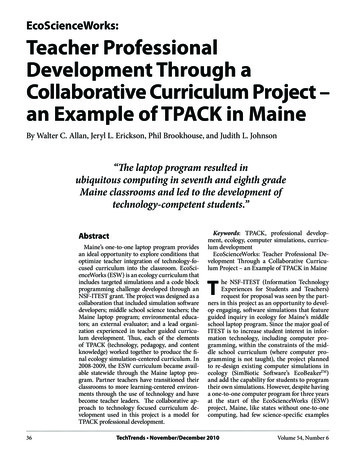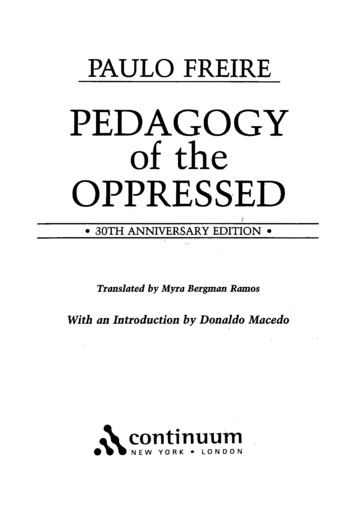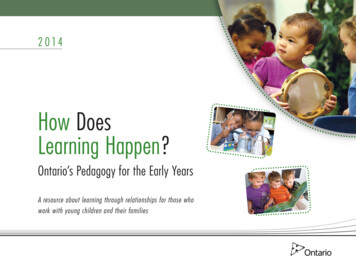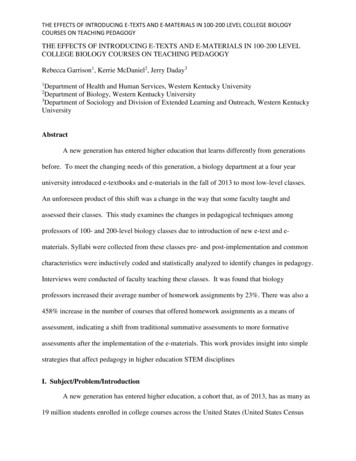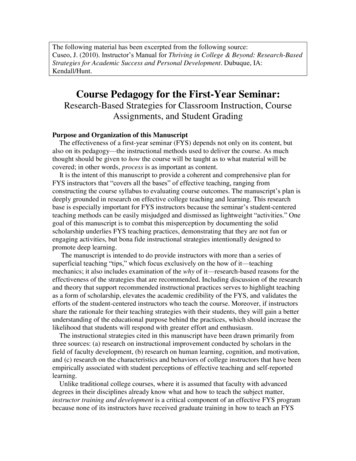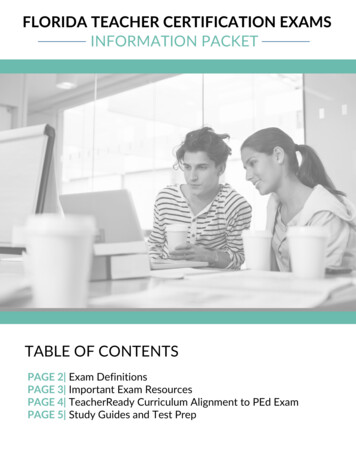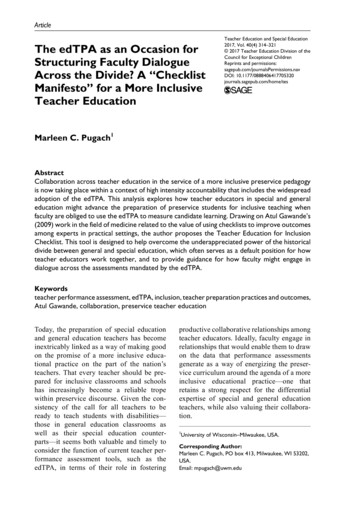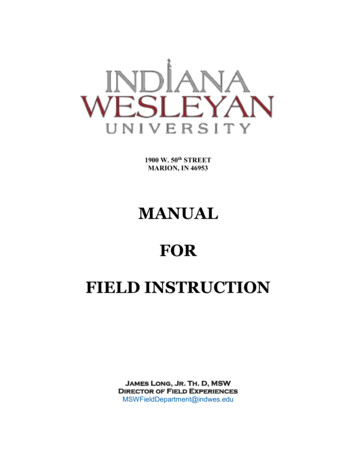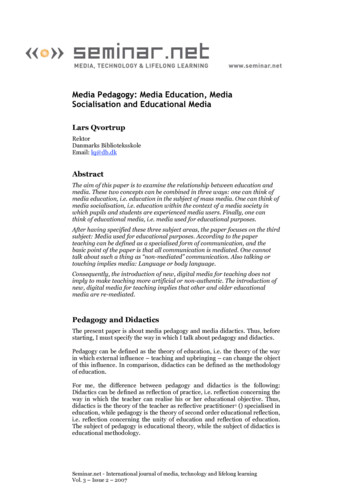
Transcription
Media Pedagogy: Media Education, MediaSocialisation and Educational MediaLars QvortrupRektorDanmarks BiblioteksskoleEmail: lq@db.dkAbstractThe aim of this paper is to examine the relationship between education andmedia. These two concepts can be combined in three ways: one can think ofmedia education, i.e. education in the subject of mass media. One can think ofmedia socialisation, i.e. education within the context of a media society inwhich pupils and students are experienced media users. Finally, one canthink of educational media, i.e. media used for educational purposes.After having specified these three subject areas, the paper focuses on the thirdsubject: Media used for educational purposes. According to the paperteaching can be defined as a specialised form of communication, and thebasic point of the paper is that all communication is mediated. One cannottalk about such a thing as “non-mediated” communication. Also talking ortouching implies media: Language or body language.Consequently, the introduction of new, digital media for teaching does notimply to make teaching more artificial or non-authentic. The introduction ofnew, digital media for teaching implies that other and older educationalmedia are re-mediated.Pedagogy and DidacticsThe present paper is about media pedagogy and media didactics. Thus, beforestarting, I must specify the way in which I talk about pedagogy and didactics.Pedagogy can be defined as the theory of education, i.e. the theory of the wayin which external influence – teaching and upbringing – can change the objectof this influence. In comparison, didactics can be defined as the methodologyof education.For me, the difference between pedagogy and didactics is the following:Didactics can be defined as reflection of practice, i.e. reflection concerning theway in which the teacher can realise his or her educational objective. Thus,didactics is the theory of the teacher as reflective practitioner1 () specialised ineducation, while pedagogy is the theory of second order educational reflection,i.e. reflection concerning the unity of education and reflection of education.The subject of pedagogy is educational theory, while the subject of didactics iseducational methodology.Seminar.net - International journal of media, technology and lifelong learningVol. 3 – Issue 2 – 2007
Media PedagogyWhat happens, when the word “media” is combined with the word “pedagogy”,i.e. when one talks about “media pedagogy”? Three things can happen. Onepossibility is that “media pedagogy” means that special kind of educationaltheory focusing on media teaching and media training. If this is the case,media pedagogy can be compared with literature pedagogy, languagepedagogy, pedagogy of physics, chemistry, natural sciences, music, art, etc.Another possibility is that “media pedagogy” means that special kind ofeducational theory, which focuses on teaching and upbringing in a mediasociety. What happens to education, when pupils and students are experiencedusers of media? Should the teacher teach differently in this social context, forinstance by training the students not to be influenced by mass media, and doesthe socialisation in a media society condition teaching differently, for instanceby making children better informed and/or more impatient? They read books– cf. the Harry Potter phenomenon – watch television, play computer games,surf the Internet, listen to i-pod music, send and receive sms’s, talk in mobiletelephones, etc. etc.The third possibility is that the word combination “media pedagogy” meansthat specialised part of pedagogy, which deals with the use and role of media ineducation. When a teacher teaches, he or she uses media. Language fortalking, blackboards for writing, body language for creating directcommunicational contact – and computers, digital networks, LearningManagement Systems, etc.Thus, “media pedagogy” can be interpreted in three ways:1.The first possible meaning is the theory of media education. How doesone teach the pupils and students to use media, and how does oneteach them about media as a phenomenon in society? This may becalled the theory of media education.2. The second possible meaning is the theory of education under thosespecial conditions that mass media represent a special aspect ofsocialisation in relation to the pupils. Pupils know the world throughthe media, and they are experienced and competent media users. Thismay be called the theory of education of media socialised children, or– in brief – the theory of media socialisation.3. The third possible meaning is the theory of education by means ofmedia: How are media used in and for teaching, from school radio andschool television to e-learning, e-portfolio and Learning ManagementSystems. This may be called the theory of educational media.Thus, “media pedagogy” is the theory of education about media, it is the theoryof education within the context of media and media society, and it is the theoryof education with media. In the following, I will outline all these possibilities.However, I will not hide the fact that I am particularly interested in the thirdpoint: How can dissemination media be used in and for teaching?I will however emphasize my first point of the present paper: That it isimportant to make a distinction between these three ways of interpreting theconcept of “media pedagogy”. Much too often these three definitions are beingmixed together.Media EducationWhat makes media education different from all other education? Is teachingmedia basically different from teaching Danish, Norwegian, mathematics,physics etc.?Seminar.net - International journal of media, technology and lifelong learningVol. 3 – Issue 2 – 20072
For me the basic difference is more than the difference concerning subject. Forme the objective is different. If one teaches Danish, Norwegian ormathematics, the objective is that the students should learn these subjects. Butthe objective of media education is to teach the students to deal withcommunication and dissemination media as producers and as users, and tobecome citizens in a so-called media society.In this respect media education is much more directly related to the basicdilemma of modern education – some call it the paradox of education – thatthe basic aim of education is through teaching to influence the students inorder not to be susceptible to influence.2 The dilemma of education is throughcommunicative influences to make children free citizens. This is of course theteleological dilemma of all education. But in media education this is verypresent in the curriculum. Here, teachers use media to influence students inorder not to be susceptible to mediatised influence. Here, teachers aim tomake students interested in media, while simultaneously teaching them todistance themselves from the influence of media.Sometimes, the administration of this dilemma has been called “housewiferesearch”.3 On the one hand one tries to prevent children from what is seen asthe harmful influence of media, on the other hand one introduces children tothe fascinating world of mass media. What is the objective of teachingcomputer games? Is it to prevent children from playing computer games, or isit to support their game abilities and aesthetic competencies in relation tocomputer games? As I have suggested, this dilemma is not unique for mediaeducation, but it represents a general pedagogical dilemma. However, thedilemma is particularly obvious in media education.Sometimes the dilemma is managed by simply choosing a particular position.Then, the objective of media education is – as it is often expressed – to turnchildren into “critical media consumers”. They should not be become “victims”of newspaper advertisements, television commercials or Internet banners, butshould be able to see through the tricks by learning their communicativeeffects. Commercials should not be loved, but unmasked.In this respect media education is different from other school subjects. Theobjective of mathematics is not to create critical mathematicians; the aim ofliterature is not to educate children to establish a critical distance to fictionwriters such as Shakespeare or Hans Christian Andersen. The literatureteacher does not aim at critical readings of The Ugly Duckling, but aims atstimulating love and fascination. But the media teacher certainly wants tostimulate critical reading of The Sun or Disney commercials, and he leavesvery little room for fascination.Sometimes this dilemma leads into a division of the subject into two parts: Aproduction part and a reception part.In the production part children are educated to be able to manage mediaproduction tools, not least computers. Here, the curriculum includesteleological as well as aesthetic elements. One should be able to use thecomputer in a targeted way in order to produce the result aimed at. And oneshould know and admire media aesthetics in order to create beautiful andfascinating products.In the reception part children are educated in order to become sceptical mediaconsumers. Here they do not produce media effects; here they unmask thesesame effects. Here they are not supposed to be fascinated, but critical.How does one manage such dilemmas or, as they are sometimes called,paradoxes? The rational approach would suggest that dilemmas or paradoxesSeminar.net - International journal of media, technology and lifelong learningVol. 3 – Issue 2 – 20073
should be solved or “untied”. But what do you do, if the paradox is a real one,i.e. if it is inextricable? Then one has to try a radically different strategy: Tomake the dilemma or paradox invisible. And this is exactly what theeducational system does.Niklas Luhmann expresses this approach in the following way:Das Erziehungssystem hat eigene Formen des Umgangs mit Paradoxenentwickelt. Es nennt sich zu diesem Zwecke “Bildungssystem”. Dabeigeht es vor allem darum, die Paradoxien zu entstören und sie so weit zuinvisibilisieren, daß sie unbemerkt bleiben können. Oder anders gesagt:die unergiebige Kurzzeitoszillation im Paradox muß ersetzt werden durchProblemstellungen, die mit Hoffnung auf Lösung der Problemeausgestattet sind.4In a free translation Luhmann says: The educational system has developed itsown ways to manage paradoxes. In this respect the educational system callsitself the system of “Bildung”, i.e. of general cultivation or cultural education.The strategy is to avoid that paradoxes make too much noise, it is to makethem invisible so no attention is paid to the paradox. Or, otherwise expressed:the unpleasant short time oscillation of the paradox has to be replaced byarticulations of the problem, which couch the problem in a hope for solution.Thus, the general answer to the dilemmas or paradoxes of education is:Bildung, i.e. general cultivation or cultural education, as a communicativetrick. “General cultivation” is a contingency formula,5 which makes it possibleto communicate about education as if it was not inherently paradoxical. Whatis the objective of education, is the question. Is it: To form children in a certainway, or is it to make them impossible to form? The answer that covers thisdilemma is: Bildung.The inherent dilemma of media education has a similar solution: “MediaBildung” or general media cultivation. This specific contingency formulacovers the doubleness of fascinated media production and sceptical mediareception.Media SocialisationAll teaching presupposes that the teacher makes a “picture” of the pupil. If theobjective of teaching is to change pupils into certain directions, i.e. to meet theaims of the curriculum and to make the students learn certain things, then theteacher must act as if the student is a simple device.However, the teacher knows that this isn’t the case. Students or pupils are notsimple devices or trivial machines, but non-trivial devices. When students areinfluenced by the interaction of the teacher, they will react in non-foreseeableways. “Their reaction on impulses will always be mediated through selfreference. That is: They will ask themselves what they can do with – or shouldunderstand – a certain input, and they can react on the same input in differentways at different moments.”6Thus, often the teacher interacts with the students or pupils as if they were,what they are not: Trivial devices. He asks them what two times two is,knowing that there is one correct answer, or he asks them when Homer wasborn, knowing that the one and only correct answer is: “That is not known”.7Translated into categories of knowledge, the teacher interacts with students asif all knowledge is factual knowledge, although it is well-known that this is notthe case.8Seminar.net - International journal of media, technology and lifelong learningVol. 3 – Issue 2 – 20074
This, thus, represents another inherent dilemma of the educational system:That teachers interact with students as if they were trivial devices, knowingthat in reality they are non-trivial devices. They communicate with students asif communication is transportation of knowledge, knowing that the basiccondition of communication is double contingency: The teacher cannotobserve the learning processes of the student, and the student cannot observethe intentional processes of the teacher’s selection of communicativeutterances.Again, there is no easy solution to this dilemma. One would not like to – andactually could not – transform students into trivial machines (althoughsometimes this seems to be the implicit effect of the intentional structure ofthe educational system). Still, however, one wants them to learn what theyhave been taught.The answer to the dilemma, that the structural coupling between thecommunication system of the class-room and the psychic system of thestudent is both necessary and impossible, is to perform yet anothercommunicative trick, i.e. to translate the contingent human being student intowhat Luhmann calls a “person”, that is into a communicatively accessibleinstance. The mechanism is that we simplify the other in order to makecommunication possible, while we know that by doing so we reduce the otherto something that he or she is not.This is of course even more acute, as teachers do not communicate with onestudent at a time, but with several students. The challenge of the teacher is notto interact with one non-trivial device, but with a non-trivial system of nontrivial devices.Consequently, one of the activities often seen among teachers is to makegeneral characteristics of pupils. They are characterised as “ the children ofour time”. To interact educationally with children in a classroom the teacherhas to typify them, for instance as “competent”, “narcissistic”, “early matured”,etc. Similarly, teachers often talk about the characteristics of a whole class:“This class is good, that other class is lazy”.In order to perform this communicative trick, the individual children must beseen as a product of a common cause. They are supposed to be “socialised”.The idea of socialisation is, among other things, a trick used by teachers tocategorise pupils and students under a common denominator. One can thentalk about spoilt children, second-generation immigration children, workingclass children, academic family children etc. And one can generalise childreninto children belonging to certain generations: Critical generations, happy-golucky generations etc. Doing so, the teacher can so to speak communicate withwhat is believed to have conditioned the children. Instead of looking into theirsouls – finding nothing – they can look into their social environment.In this respect so-called “media socialisation” is a communicative trick. It is away of reducing children into a simple category, thus acting as if classroomteaching is possible. In order to construct the generalised communicativeother, one can include him or her into the media socialised general other andact in correspondence with this generalisation. He or she can be said to havingbeen socialised through media, and to having made his or her worldexperiences through media. Students of our times are “products of the media”,“Disney-fied”, they are “in lack of first order experience”, etc.But isn’t this true? No, if it is correct that society and humans – psychicsystems – are mutually closed systems, human beings are not a simple productof society. Norms, patterns, traditions etc. cannot be transmitted from onegeneration to the next. Rather, the mechanism of socialisation should beanalysed as a mechanism of expectations.9 The child or the young person canSeminar.net - International journal of media, technology and lifelong learningVol. 3 – Issue 2 – 20075
observe the communication of the older generation, the teachers or the otheryoung people, and he or she can react through adaptation or deviation. ShouldI accept their communicative offer, or shouldn’t I?This is of course also the fact at the next level of observation. The youngperson observes the expectations of the other, or he observes the reactionsfrom the other on his being this or that.In this respect socialisation is more “free” then education. Socialisation ischaracterised as structures of expectations, but whether the other fulfils yourexpectations is not important. Actually, it may be seen as positive if the otherdeviates from the expected outcome.But education is goal-oriented communication. Children and students shouldlearn something according to the curriculum, and they may react against theseobjectives. Therefore, as Luhmann notices, it is an old pedagogical trick toorganise education as situations, which are supposed to actualise a certainsocialisation potential. One might for instance identify pupils as media societychildren and provide them with computers, mobile telephones and treat themas experienced media practitioners – and this might then have a positiveoutcome in relation to the curriculum.Educational MediaUntil now I have looked at the two first aspects of media pedagogy: Mediaeducation and media socialisation. Media education is about the way in whichteaching students how to use media can be organised and practised. Mediasocialisation is about the way in which teaching can be organised andpractised, assuming that students have a common socialisation in media andin media society.The rest of the paper I will however devote to the third subject: How to usemedia in and for education. I will do so by discussing the question: What is atheory of educational media, that is a theory of teaching which has a specialfocus on the use and function of media in teaching?On the face of it one should think that this would be a theory about the specialand atypical type of teaching that is performed by means of radio, televisionand new, digital media. Thus, this would be a theory about school-radio,school-television, distance learning, computer-supported learning, etc.However, I would suggest that a theory about educational media should have amuch broader definition. It is my hypothesis that all teaching is teaching usingmedia, that is, all teaching is mediated. I would like to draw a sketch of thedimensions of that particular field of pedagogy, which can be called the theoryof the function of media in upbringing and teaching. I would suggest that sixdimensions could be identified: First, I will argue that all teaching is mediated. This is the basicstatement of media pedagogy.Second, I will describe the functionality of media in teaching as aspecialised form of communication: Why are media used?Third, I will look at the reflexivity of educational communication. I willdemonstrate that educational communication includes first order aswell as second order reflection, and that educational media shouldmake reflections at both levels possible.Fourth, I will analyse the basic aspects of education, namely themediation of the relations between student and subject, teacher andstudent and teacher and subject. Each relationship calls forward aspecific media type.Seminar.net - International journal of media, technology and lifelong learningVol. 3 – Issue 2 – 20076
Fifth, I will clarify the dimensions of educational communication, i.e.that one dimension of education is the one connecting rules and selforganization, while the other dimension is the one connectingvirtuality and reality, and I will demonstrate the way in whicheducational media mediate these dimensions.Finally, I will look at the theory of educational media from a mediaspecific approach. I will analyse a couple of specific examples of mediagenres such as playgrounds and computer games in order todemonstrate the analytical potentials of the above-mentionedconcepts and categories.All teaching is mediatedIt is often heard that one can make a distinction between mediated and nonmediated communication, and thus between mediated and non-mediatedteaching. The idea is that there is some kind of particularly “authentic”interaction and teaching, one in which the social distance between thecommunicators – e.g. between teacher and student – has been eliminated.They have established an “authentic” relationship.10For me, this is an illusion. All teaching – and all communication – is mediated.Also when sitting in front of the particular other in an educationalrelationship, this relationship is mediated. Yes, the very fact that thisrelationship is not any relationship, but a relationship of upbringing orteaching, represents a mediation. Also when talking to each other, verballanguage, gesture etc. are media. Thus, all education, and indeed allcommunication, is mediated.One could of course reply to this position that there is a marked differencebetween on the one hand language, gesture etc. and on the other handtechnical media such as printed books, broadcasting programmes or elearning systems. For me, however, it is important to emphasize that language,gesture and technical dissemination media are related. First of all, they areevolutionary related. No communication media is “authentic”. Language is aproduct of social evolution as well as the Internet. Secondly, they arefunctionally related. They are means for making communication less unlikely.This position can be substantiated as follows. Education, i.e. upbringing andteaching, is a particular form of communication, namely that form ofcommunication whose objective is to change individuals (pupils, students,adult students) into a certain direction. More precisely, teaching is aspecialised form of communication whose objective is based on a pedagogicalintention to provide a person or a group of persons with knowledge and/orabilities.11 This in itself represents a mediation. Educational communicationoccurs in the medium of a code, through which one can decide, whether thiscommunicative action actually is teaching, or something else. Also, based onthe code one can decide, whether the communication was successful. Dideducation actually happen?Thus, just by being “education” and not conversation, negotiation, decisionmaking etc. the communication is mediated, because one code and not othersis applied.In addition, however, we know that the possibility for this communication tobe successful is limited. When one educates a child, it is difficult to say,whether the upbringing is a result of the child’s self-socialisation, or the resultof the specific educational communication. Is the child taught to walk, or doesit learn – does it teach itself – to walk? Is it taught to talk, or does it learn totalk? Here, it is relevant with Luhmann to say that teaching is a specialisedexpression of the general improbability that “systems understand systems”,12Seminar.net - International journal of media, technology and lifelong learningVol. 3 – Issue 2 – 20077
i.e. that one closed system should be able to observe another closed system insuch a way, that the result is understanding. Yes, it is a piece ofdisingenuousness to say that one psychic system observes the other. Rather,one system, i.e. the pupil, observes another system, namely the system ofeducational communication, personalized in communicative decisions madeby a generalised other: The teacher.In order to generalise this position, one can say – as does Luhmann in DasErziehungssystem der Gesellschaft,13 – that the theory of education mustmake use of two basic concepts: Operative closure and structural coupling.14The concept of “operative closure” characterizes both the child and theeducational communication. The child is a closed system, which based on itsown operations, i.e. based on preconditions that it can only create itself,observe communicative operations in its environment. My one-year-oldgrandchild obviously observes what I am doing and saying, but what sheactually sees and understands, and why she reacts in one particular way andnot another, is not observable for me. I can see that she observes, but Icertainly cannot see what she sees or why she reacts in one way or the other.Suddenly she makes an utterance. But why did she do it now and not a monthago (actually I have said “book” hundreds of times, when she points to myshelves, without any other reply than what I interpret as “what’s that?”) isbeyond the potentials of my understanding. Certainly, however, it is the resultof her own operations and not of my utterance: Something in her makes herreact.In a similar way one can think of the educational communication as anoperatively closed process, the environment of which is – children. Theteacher talks, demonstrates, makes gestures and drawings on the blackboard,but whether this affects the pupils, and in which way it does so, is in principleimpossible to know. And seen from the position of the childrencommunication occurs – just think of my grandchild – but how should it beunderstood?However, the result is not an absurd Leibnitzian dance of isolated monads.The idea is that contact is made, but not in the sense of causal input-outputprocesses, but in the sense of structural couplings. A “structural coupling” is acoupling made by one system and based on operations of this particularsystem. I observe my environment through the operations of my cognitivesystem, not as the environment exists “an sich”. And of course I observe myselfobserving my environment.15Structural couplings can have two different basic effects. One is that onesystem limits the operational potentials of the other system. Although I – andnot my brain – think, in order for my cognitive system to work it must makestructural couplings to the neural processes of the brain. Consequently, noteverything can be seen and thought. For instance, what I can observe it limitedby the visual potentials of my eye. Similarly, in order to be systematicallystimulated to learn, the child must go to school. But staying at school the childis not allowed to leave the classroom, and the learning stimulation couplingsare limited to what the school offers.The other effect, which I have already indirectly mentioned, is that one systemprovides resources to the eigen-operations of the other system. In order tothink, I must have a brain with a complex system of neural operations, but – asalready said – it is not the complex system of neural operations that thinks,but “me” that do so thanks to the resources provided by my neural system. Thesocial system communicates, but it does so thanks to the resources providedby the structurally coupled individuals – or psychic systems – in itsenvironment. When observing the educational communication the child canobserve phenomena that can be used as resources for its own operations. TheSeminar.net - International journal of media, technology and lifelong learningVol. 3 – Issue 2 – 20078
small child can copy the sounds and gesture of the adult person and use this asresources for its own, continued eigen-operations.Also in order to make structural couplings possible media must be applied.Media are so to speak the evolutionary outcome of structural couplings, and itis the function of media to make the improbability of successfulcommunication less improbable. In the educational context media are used inorder to make it more probable that the educational communication has thepremeditated effect. Indeed, educational communication is mediated. We allknow that we talk differently – more clear, more simple and with a moreexplicit orientation towards the intended effects – when we talk to a childwithin an educational context. However, mediation of educationalcommunication is not an exception. On the contrary: All communication ismediated. Such a thing as unmediated communication does not exist.Educational Media: Dissemination, Understanding and EffectAn analysis of communication, both in general terms and in relation to thespecial type of educational communication – implies that three types ofimprobability for successful communication can be identified.Just think of the normal classroom experiences: First of all, it is not probablethat the pupils should hear what is being said. Secondly, it is not probable thatthey understand, what is being said. Thirdly, it is not very likely that thechildren – if, against all odds, they have heard and understood what was said –react to what has been uttered in accordance with the intention of thecommunication. This can be illustrated by Luhmann’s own example from theevening meal in his family. When he said to the children that they should washtheir hands, they didn’t hear it. They were too busy doing their own things.When they, after all, heard what he said, they didn’t understand it. Theylooked at their hands and simply couldn’t understand what was meant. “Dirty?What do you mean?” And when they finally understood it, they didn’t reactaccordingly, but continued doing what they thought was more important,silently backed up by their gentle mother, who let the family understand that itwasn’t after all that important.A similar example has been provided by Søren Kierkegaard. He presented oneof his ethical
Ð cf. the Harry Potter phenomenon Ð watch television, play computer games, surf the Internet, listen to i-pod music, send and receive smsÕs, talk in mobile telephones, etc. etc. The third possibility is that the word combination Òmedia pedagogyÓ means that specialised part of pedagogy,
